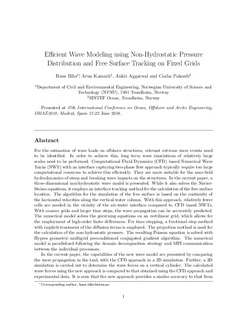| dc.contributor.author | Bihs, Hans | |
| dc.contributor.author | Kamath, Arun | |
| dc.contributor.author | Aggarwal, Ankit | |
| dc.contributor.author | Pakozdi, Csaba | |
| dc.date.accessioned | 2019-05-14T09:35:28Z | |
| dc.date.available | 2019-05-14T09:35:28Z | |
| dc.date.created | 2018-09-26T14:27:03Z | |
| dc.date.issued | 2018 | |
| dc.identifier.isbn | 978-0-7918-5121-0 | |
| dc.identifier.uri | http://hdl.handle.net/11250/2597537 | |
| dc.description.abstract | For the estimation of wave loads on offshore structures, relevant extreme wave events need to be identified. In order to achieve this, long term wave simulations of relatively large scales need to be performed. Computational Fluid Dynamics (CFD) based Numerical Wave Tanks (NWT) with an interface capturing two-phase flow approach typically require too large computational resources to achieve this efficiently. They are more suitable for the near-field hydrodynamics of steep and breaking wave impacts on the structures. In the current paper, a three-dimensional non-hydrostatic wave model is presented. While it also solves the Navier-Stokes equations, it employs an interface tracking method for the calculation of the free surface location. The algorithm for the simulation of the free surface is based on the continuity of the horizontal velocities along the vertical water column. With this approach, relatively fewer cells are needed in the vicinity of the air-water interface compared to CFD based NWTs. With coarser grids and larger time steps, the wave propagation can be accurately predicted. The numerical model solves the governing equations on an rectilinear grid, which allows for the employment of high-order finite differences. For time stepping, a fractional step method with implicit treatment of the diffusion terms is employed. The projection method is used for the calculation of the non-hydrostatic pressure. The resulting Poisson equation is solved with Hypres geometric multigrid preconditioned conjugated gradient algorithm. The numerical model is parallelized following the domain decomposition strategy and MPI communication between the individual processors. In the current paper, the capabilities of the new wave model are presented by comparing the wave propagation in the tank with the CFD approach in a 2D simulation. Further, a 3D simulation is carried out to determine the wave forces on a vertical cylinder. The calculated wave forces using the new approach is compared to that obtained using the CFD approach and experimental data. It is seen that the new approach provides a similar accuracy to that from the CFD approach while providing a large reduction in the time taken for the simulation. The gain is calculated to be about 4.5 for the 2D simulation and about 7.1 for the 3D simulation. | nb_NO |
| dc.description.abstract | Efficient Wave Modeling Using Non-Hydrostatic Pressure Distribution and Free Surface Tracking on Fixed Grids | nb_NO |
| dc.language.iso | eng | nb_NO |
| dc.publisher | ASME OMAE conference paper | nb_NO |
| dc.relation.ispartof | ASME 2018 37th International Conference on Ocean, Offshore and Arctic Engineering - Volume 2: CFD and FSI | |
| dc.title | Efficient Wave Modeling Using Non-Hydrostatic Pressure Distribution and Free Surface Tracking on Fixed Grids | nb_NO |
| dc.type | Chapter | nb_NO |
| dc.type | Peer reviewed | nb_NO |
| dc.description.version | acceptedVersion | nb_NO |
| dc.identifier.doi | 10.1115/OMAE2018-78158 | |
| dc.identifier.cristin | 1614130 | |
| dc.description.localcode | This work was published at ASME 2018 37th International Conference on Ocean, Offshore and Arctic Engineering. Madrid, Spain, June 17–22, 2018.The final version is available at DOI 10.1115/OMAE2018-78158 | nb_NO |
| cristin.unitcode | 194,64,91,0 | |
| cristin.unitname | Institutt for bygg- og miljøteknikk | |
| cristin.ispublished | true | |
| cristin.fulltext | postprint | |
| cristin.qualitycode | 1 | |
